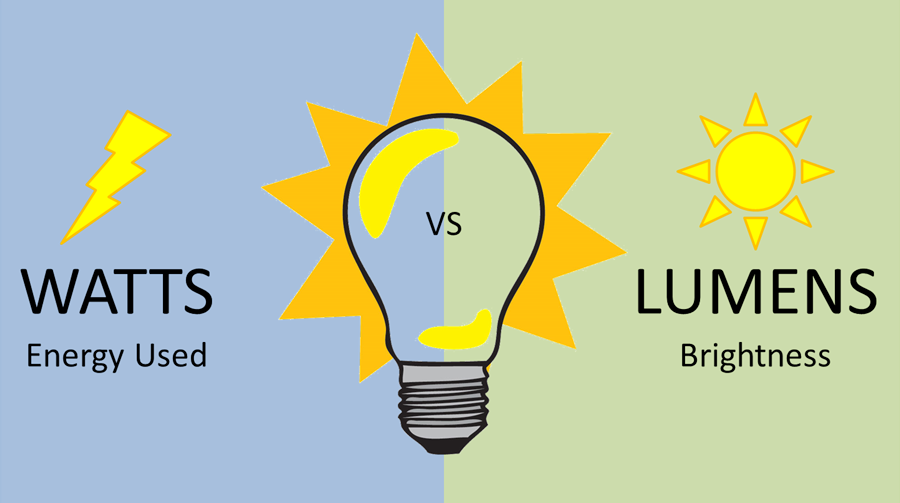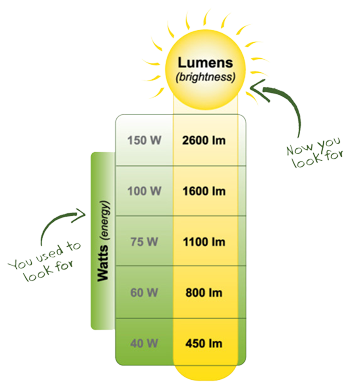


 With the push for LED lighting, there is a lot to take into consideration now for lighting levels. One of the biggest arguments is light Wattage versus the Lumens and determining brightness. The old way of looking at how bright a light will be is to look at the wattage, and with incandescent lamps, the higher the wattage the lamp is, the brighter it is. Now we need to focus on the Lumens of the lamp to determine the brightness of the lamp, especially when it comes to LEDs.
With the push for LED lighting, there is a lot to take into consideration now for lighting levels. One of the biggest arguments is light Wattage versus the Lumens and determining brightness. The old way of looking at how bright a light will be is to look at the wattage, and with incandescent lamps, the higher the wattage the lamp is, the brighter it is. Now we need to focus on the Lumens of the lamp to determine the brightness of the lamp, especially when it comes to LEDs.
The Wattage of the light is the amount of energy it takes to produce a certain amount of light. The higher the wattage, the brighter the light, but also the more power it uses. The efficiency of this system was introduced using incandescent lamps.
For instance:
This was an inefficient way of lighting and there have been many advances, such as the introduction of fluorescent and compact fluorescent lighting as well as metal halide, low pressure sodium and high pressure sodium. Fluorescent and compact fluorescent produce better lighting with lower wattage; however, have some environmental factors to take into consideration. Metal halide, LPS and HPS produce better lighting than standard incandescent; however, they are typically much higher in wattage and use much more power than their CFL or LED counterparts.
For instance:
Switching to CFL or LED can provide the same or better lighting while using a fraction of the original power. For example, I use 7 Watt LED bulbs in my kitchen can lights and it is very bright. This was switching out from 32 Watt CFL lamps. Outside there were three 150 Watt incandescent bulbs for around a 150 sq ft area and have since been replaced with 13 Watt CFL lamps. Now the areas are lit with much better lighting while only costing a small percentage of the original power requirement.
A lumen is the amount of light a certain lamp gives off. If replacing a standard 150 Watt light bulb which gives off around 2600 Lumens, using a 42 Watt CFL or a 25 Watt LED is about the equivalent. This lowers the needed power of the light by over a quarter of the required power to produce the same light. A 70 Watt LED fixture can produce 7000 Lumens or more and replace most highway and parking lot lighting fixtures to a more efficient and cost effecting light. This is becoming more efficient every day.
Solar lighting needs to take into consideration both the Lumens and the Wattage of a lamp. The wattage provides the needed power from the solar power and battery system to power the solar light fixture for the required amount of time and the Lumens determines how much light is given off by the lamp. The more efficient the fixture or lamp is, the more efficient the solar and the lower the cost of the complete system.
Solar lights are also typically lower to the ground and then can produce more lighting with a lower Watt lamp and using a higher Lumen efficiency. Want to know more about solar and LED lighting, check out: Why Solar Power and LED Lighting Makes a Perfect Combination.
Most solar lighting systems use fixtures ranging from 20 Watt LED (2000+ Lumens) to 90 Watt LED (9000+ Lumens) and are typically in the 35 Watt to 50 Watt range for most applications. High security or light level requirements use the brighter lights and residential and remote areas use the lower range.
And since most well manufactured LED fixtures, such as the Hubbell fixtures, provide directional LED. This means the lights is directed at the ground with specific distributions to provide the required coverage. Standard lamps are round and provide light / Lumens in all directions, whereas the LEDs push the light directly to the area it is needed. One of the biggest mistakes are people making the switch from older lamps at around 400 Watts and only moving down to a 300 Watt LED. A much lower wattage LED can be used. The ASL fixture provides replacements for 150 Watt, 250 Watt and 400 Watt HPS and MH lights using fixtures with a Wattage of 62 Watts, 123 Watts and 181 Watts.
In the end, taking into consideration the lighting levels and Lumens over the Wattage of the lamp will provide a more energy efficient lighting system. Higher Lumen and lower Wattage lamps, especially with LEDs, will provide the best lighting with the lowest energy costs.
Editor's Note: This post was originally published in July 2014 and has been completely revamped and updated for accuracy and comprehensiveness.
